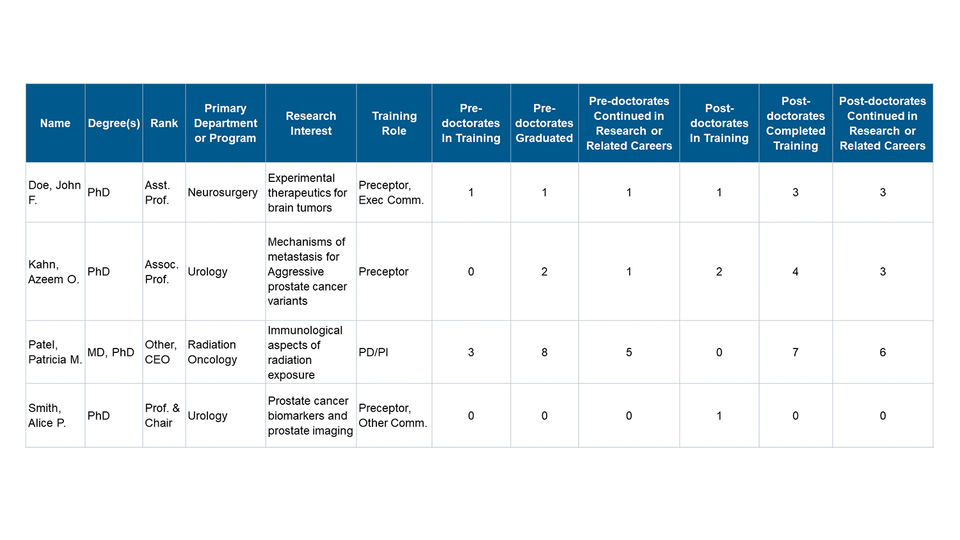Table 2. Participating Faculty Members
Overview
This table should demonstrate that your program has a robust and appropriate group of mentors in terms of rank, research interest, department, mentoring history, and former trainee outcomes.
Overall Instructions
-
List participating faculty in alphabetical order by last name.
-
Columns 1-6 refer to basic information about the faculty member (name, degree, rank, etc.).
-
Columns 7 – 12 refer to the faculty’s mentoring record of pre- and post-docs who have been or are currently engaged in research training under the faculty’s primary supervision over the past 10 years. Visit our FAQs for more information about who the NIH classifies as an appropriate trainee.
-
Primary supervision means that the faculty directed the trainee’s pre-doc dissertation or post-doc research project (general dissertation committee membership does not apply).
-
Note that each faculty must list all of their pre- and post-doc trainee data regardless of training program focus (i.e. only pre-docs or only post-docs).
-
Only include pre-doc MD students if they are ALSO pursuing PhDs OR taking a gap year(s) to pursue mentored research.
-
Exclude from these totals:
-
Pre-docs doing research rotations
-
Clinical interns and residents unless they have been or are currently doing full-time, mentored research training in the faculty member’s research group/lab
-
K awardees
-
MD students who are not are also pursuing a PhD
-
-
-
Page Limit: None. For more information visit our FAQs.
Summarize Table 2 data in the Research Training Program Plan narrative Background and Program Faculty subsections. Explain the rationale for selecting mentors, overall mentorship experience, and justification for including faculty with limited experience. While NIH does not specify the number of mentors, projects should have a focused and diverse group with sufficient expertise to fully support any potential future trainees.
Helpful Hints
Strong Mentorship
- On the whole, mentors should have strong training backgrounds illustrated by the number of past and present trainees. For mentors with minimal mentorship experience, make a compelling case for their inclusion within the written Program Plan. If not, consider adjusting their participation in favor of more experienced faculty members.
- While it is acceptable to have some junior faculty on the grant, they should be well supported by the program plan to ensure their trainees’ productivity. To address any potential concerns, indicate that junior mentors will work with more experienced mentors, clarify why they have a break in training, or explain why their unique skillset are invaluable for the program’s success. Many agencies encourage team mentorship, so you can consider pairing junior faculty with a team of more senior mentors.
- Example: Dr. Smith does not have any past trainees on record and has just 1 pre-doc in training. Dr. Malik has 5 pre-docs and 4 post-docs who graduated and continued into research careers but no current pre- or post-docs in training. As a new faculty member, your team determines to pair Dr. Smith with Dr. Kahn, who is a more experienced mentor, to keep Dr. Smith on the grant. Dr. Malik recently returned for a 3-year sabbatical but has not expressed vested interest in the training grant, so you remove them from the grant.
Guidance by Column
- Name. Last Name, First Name and Middle Initial
- Degree(s). Only include post-grad degrees (MD, PhD, etc.)
- Rank. Rank should correspond to the primary department listed in column 4; for non-academic positions list “Other” followed by their title
- Primary Department/Program. The department, interdepartmental program, division, etc. that will actively host trainees
- Research Interest. Must be relevant to the proposed training program; be brief, keywords okay to use
- Training Role. Select up to three; allowable options include:
- PD/PI
- Preceptor or Mentor
- Executive Committee Member (Exec. Comm.)
- Other Committee Member (Other Comm.)
- Other
- Predoctorates in Training. Number of pre-doc trainees currently under the faculty’s supervision; if the faculty does not have trainees, list 0
- Predoctorates Graduated. Number of pre-doc trainees who earned a doctoral degree that the faculty mentored over the past 10 years; if the faculty does not have trainees, list 0
- Predoctorates Continued in Research or Related Careers. Number of pre-doc trainees who earned a doctoral degree during the past 10 years and are currently in a research-related career*
- Postdoctorates in Training. Number of post-doc trainees currently under the faculty member’s supervision; if the faculty does not have trainees, list 0
- Postdoctorates Completed Training. Number of post-doc trainees who completed training under the faculty member’s supervision over the last 10 years; if the faculty does not have trainees, list 0
- Postdoctorates Continued in Research or Related Careers. Number of post-doc trainees who completed their training under the faculty member’s supervision over the last 10 years and are currently in a research-related career*
*Research-related careers can include teaching, administering research or higher education programs, science policy, technology transfer, etc. Additionally, pre-docs who have completed training and moved to post-doc training should be included in this category.
Sample Table 2
Note: Follow NIH formatting guidelines – this is a visual demonstration and does not reflect NIH formatting or accurate information/data.
Table 2. Participating Faculty Members

Templates
- NIH Blank Template: Table 2 (Microsoft Word)
- Contact GSUTraining@mednet.ucla.edu for formatted Microsoft Excel templates
NIH Resources
-
Data Table Form Library (Please note as of January 2023 NIH is still utilizing FORMS G for Data Tables)
- Consolidated Sample Data Tables and Instructions (Microsoft Word)
- Blank Data Table Template (Microsoft Word)
- Data Table FAQs